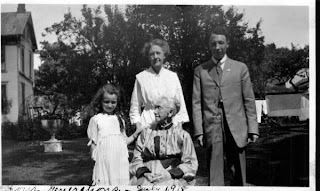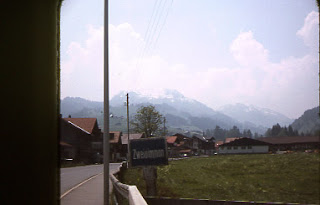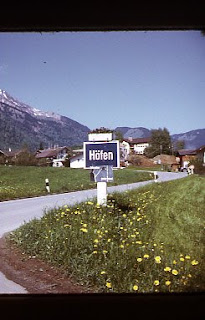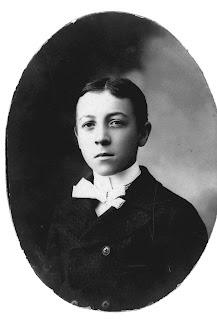Maffli is the official spelling of the surname in the Swiss Book of Family Names (Familienbuches der Schweiz), which lists the Bernese Maffli primary ancestral home as Höfen-Amsoldingen bei Thun, and secondary ancestral homes of Oberdiessbach and Buchholterberg. The name form is typically Alemannic German, a patronymic, meaning son of Maff. Maff could be a nickname for Magafrid (personal communication from Elsdon C. Smith, book author and former head of the American Name Society). Magafrid would be a typical two-theme Germanic name. Maga- = Macht (strength, in modern German), plus –frid = Fried (peace).

There is a record that Christian and Barbara Maffli were the parents of our known ancestor Niclaus Maffli (Nicholas Muffley). This information was submitted to the Latter Day Saints Church (www.familysearch.org) by a member, with no other information. Until the Amsoldingen church records are transferred to the Bern Archives, and data placed for sale on CD-ROM, this cannot be confirmed, short of another visit to Höfen-Amsoldingen bei Thun. Christian Maffli was reportedly born on May 3, 1685, at Amsoldingen, Bern Canton, Switzerland. Barbara was born about 1686 at Amsoldingen. Christian and Barbara were reportedly married about 1707, and their son Niclaus Maffli was born in February, 1707/1708. Niclaus reportedly had a brother, Heinrich Jacob Maffli, born in 1715 at Amsoldingen. (pictured above is
- McCreary-Muffley 4 generations)

Niclaus/Nicholas once lived (data found while I was in the Bern Archives) in Zweisimmen District, Bern Canton, Switzerland. Go
here and Click on “Summer Panoramic Map” (which faces south) and slide to the right (west). Note the position of Zweisimmen, up the valleys from Lake Thun. Höfen-Amsoldingen bei Thun lies between Thun and Zweisimmen. At some point prior to his emigration, Niclaus Maffli moved out of the lower land by Lake Thun (Thunersee) to Zweisimmen in the Bernese Uplands (Oberland). It looks like in so doing, he moved from an area of High Alemannic dialect to an area of
Highest Alemannic dialect. Maffli would have been pronounced Moofli in the south Bernese dialect, I was told by Swiss genealogist Franz Walter Kummer-Beck. I think that Niclaus probably lived in the Zweisimmen vicinity long enough that he assimilated the different pronunciation of his surname. Upon departure from Switzerland and arrival in America, our ancestor Niclaus Müffli used a “ü”, probably to fit the spelling in other regions to his pronunciation of his name. Modern Swiss cousins spell the name Mafli or Maffli, and I have corresponded with, and met in Basel, Maffli descendants of Höfen origin. Perhaps y-DNA testing could confirm the link of our Muffley line and any known Höfen-origin male Maffli.

In the course of three trips to Switzerland (1967, 1973, 1977), I visited the main Maffli ancestral village of Höfen-Amsoldingen bei Thun, west of Lake Thun in Bern Canton, a secondary Maffli ancestral village of Oberdiessbach, as well as Zweisimmen, and the Bern Archives. I interviewed Swiss genealogist Dr. Robert Oehler in his home, and he provided some Maffli names, the oldest being a Peter Maffli born in 1588 in Oberdiessbach.
“N. Muffli” (Bern Archives) listed Zweisimmen as his home when he paid the Swiss emigration tax, 1734-1735. The tax of 10% of his total worth (about 12 pounds) was not much money, so Niclaus was by no means wealthy then. Zweisimmen, in the south of Bern Canton, is not far from St. Stephan village; both are in the Upper Simmen Valley (Obersimmental). When Niclaus took ship from Rotterdam to Pennsylvania in 1737, a fellow passenger (next line on the roster) was Christian Jäggi, from St. Stephan. Christian became the father of Maria Barbara Yockey, who married our ancestor John/Johannes Muffly. It is not known if Nicholas & Christian knew each other in Switzerland, or met later. An hour or so at the Bern Archives would probably turn up Christian’s exit tax record, and I wouldn’t be surprised to find it in close proximity to that of Niclaus. It might also be the case that Niclaus and Christian were neighbors in the Obersimmental, but on opposite sides of a Gemeinden (municipalities) border.
There is a gap in time between when Nicholas paid his 1734-1735 “Abzug” emigration tax, and his taking ship from Rotterdam in 1737. Where was he, and how did he manage to accumulate money for onward travel? When he arrived in America, on Oct. 31, 1737, his ship “William” was said to be carrying of a group of Palatines. However, experts have noted that the term “Palatines” was used carelessly, and included other Germanic groups. Some of Nicholas’ shipmates in fact came from Baden-Würtemberg, especially from southeast of Heidelberg. It is noteworthy that when, or shortly before, Nicholas left Switzerland, the Rhineland was in a bit of turmoil due to the War of Polish Succession. The French had overrun the Rhineland in 1734. It was no doubt an interesting time to be headed down the Rhine. I wonder if Niclaus might have been more comfortable stopping awhile before he left Alemannic dialect territory, say in Alsace or Baden.
Niclaus & Christian sailed from Rotterdam, Netherlands, aboard the ship “William”. The ship’s master was John Carter, and there were 180 passengers. There was a stop at Dover, England (the British required such a stop en route to their colonies). The ship arrived at Germantown (Philadelphia) on Oct. 31, 1737, and Niclaus took an oath at Philadelphia courthouse that day. “Niclaus Müfli” was his signature in early America, and by 1752 it was “Nicholas Muffly”.
MUFFLEY y-DNA, AND SWITZERLAND
(11/08 update)
It now appears (www.familysearch.org) that Muffley ancestry can be traced back to Christian and Magdalena Juzeler Maffli, paternal grandparents of Niclaus Maffli (b. Feb. 1707/1708). Christian Maffli Sr. was reportedly born about 1655 at Amsoldingen, Bern Canton, Switzerland. Magdalena Juzeler was reportedly born at the same location about 1657. Christian & Magdalena were married on November 4, 1678. Their children reportedly were: Peter, Anna, Elizabeth, Magdalena, Christian Jr. (father of Niclaus), Hans, and another Magdalena (presumably the first had died).
Thus, my Y-Chromosome SNP (single nucleotide polymorphism) marker presumably is identical to that of my 7th Great-Grandfather Christian Maffli Sr., born about 1655, i.e. 288 years before my birth. It is possible to gather some information stretching back much further in time on the male line.
A SNP (single nucleotide polymorphism) is a change to a single nucleotide in a DNA sequence. The mutation rate is extremely low over the millennia, so that this genetic information can be used as an aid to understanding human history. Each mutation point defines a new
Haplogroup, and these suggest geographical points of origin of male ancestors. In the Swiss population are found at least 7 common male Haplogroups, so far as I understand, including E3b, G, G2, J, I1b2, R1a1, & R1b.
I have had a simple kind of SNP testing done. My Haplogroup was determined to be R1b1c. This marker has its highest concentration in the Irish and Basque peoples, but is widespread throughout Western Europe.
The M269 genetic marker defining R1b1c may have originated in central Asia, and was widespread in Europe throughout Paleolithic times. Men with this genetic marker are believed to have been associated with the Aurignacian Culture (say, ±32,000-21,000 B.C.?) of the Upper Paleolithic Age. These people were the cave painters of southern France, Spain, and Portugal. There were advances in flint tools. Hunting points were from antler, bone, and ivory. There were no atlatl spear-throwing sticks, or bows and arrows. There was body ornamentation. Concentrations of the culture were in several locations surrounding Switzerland, but not so much within modern Switzerland itself.
During the last Ice Age (=Last Glacial Maximum), men of the R1b1c Haplogroup are believed to have withdrawn to the Iberian Peninsula (one of the Ice Age “Refugia”), and then to have repopulated Europe beginning about 15,000 years ago.
Further
genetic subclade testing of myself might be helpful. Reportedly, R1b1c10 (Continental Celt, probably of the Helvetii Tribe) is common in Switzerland. Pending further genetic testing, my Deep SNP subclade is likely either R1b1c10 (Continental Celt), or R1b1c9 (likely the Alamanni/Alemanni, a Germanic group which came later into Switzerland). (see now my recent
9/09 Genetic testing Update!)
Switzerland has sites of both Hallstatt and La Tène Celtic culture. The Helvetii Celts reportedly moved from southern Germany into Switzerland by the late 2nd Century B.C., pushed south by Germanic groups. The Helvetii were settled on the Swiss plateau in the 1st Century B.C., and were mentioned in Julius Caesar’s “Commentary on the Gallic War”. A bit of Helvetii history is at
http://en.wikipedia.org/wiki/Helvetii#Earliest_historical_sources_and_settlement The Helvetii eventually came under Rome’s rule. Maffli ancestral homes in the Aare River Valley were centuries earlier settled with Celts.
Later during Roman times, the
Alamanni Germans moved into Switzerland from the north. Well after the fall of the Roman Empire, Alemannia came under Frankish rule, and later under Habsburg rule. The Habsburg family’s power had actually begun with Radbot of Habsburg, who about 1020 built a castle of that name in northern Switzerland.
Switzerland’s traditional founding occurred in 1291 with the confederation of the Cantons Uri, Schwyz, and Unterwalden. Bern Canton and others joined the confederation in 1353. Maffli traditional homes in the Aare Valley of Bern Canton came under the rule of the Zähringen and Kyburg dynasties. Thun Castle (Zähringen and Kyburg families) and Spiez Castle are fairly close to the main Maffli ancestral home of Höfen-Amsoldingen bei Thun. In time, patrician families became more autocratic. The Swiss Peasants’ War of 1653 occurred two years before the birth of Christian Maffli Sr., and did involve Bern Canton. This was only a few years (since 1648) after Switzerland became totally independent from the Holy Roman Empire.
In the time of Maffli-surname (at least back to the 1500s), people in the Aare River Valley spoke a High Alemannic dialect. Niclaus Maffli moved from his birthplace at Amsoldingen, near Lake Thun, to Zweisimmen, an area of Highest Alemannic dialect. In the latter dialect, Maffli was pronounced “Moofli” and so the spelling upon migration to America in 1737 found the “a” changed to “u”: Muffley.
 This blog narrative, shorn of many details and documentation, presents over three centuries of family history of my Muffley line. Our tale begins in Bern Canton Switzerland, and traces the Muffley migration to the New World. American locations of particular interest include southeastern Pennsylvania, western Pennsylvania, Illinois, Missouri, and southwestern Nebraska. My Muffley line is: Christian - Nicholas – Johannes – Jacob – Thomas – Joseph – Albert - Robert – Gary (me).
This blog narrative, shorn of many details and documentation, presents over three centuries of family history of my Muffley line. Our tale begins in Bern Canton Switzerland, and traces the Muffley migration to the New World. American locations of particular interest include southeastern Pennsylvania, western Pennsylvania, Illinois, Missouri, and southwestern Nebraska. My Muffley line is: Christian - Nicholas – Johannes – Jacob – Thomas – Joseph – Albert - Robert – Gary (me).


